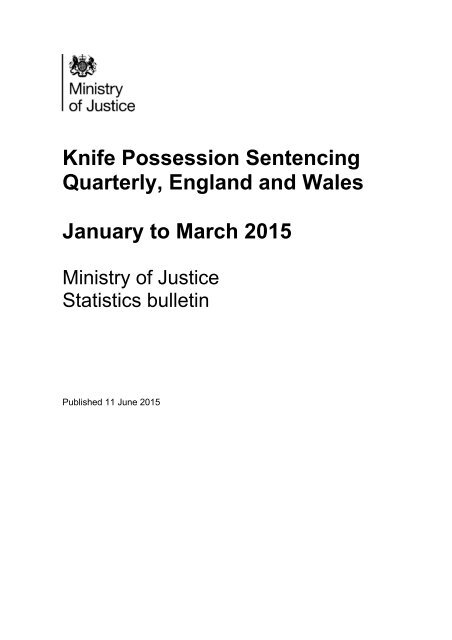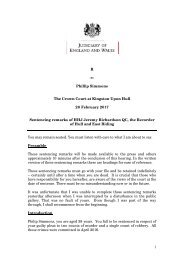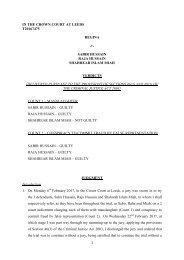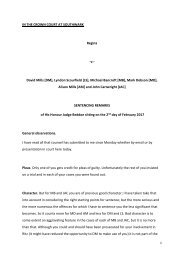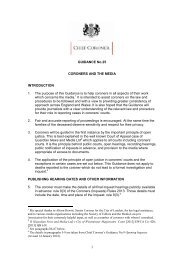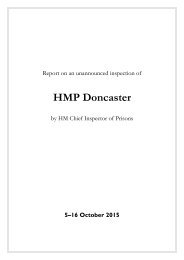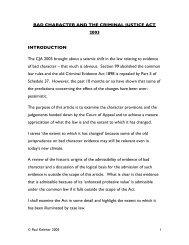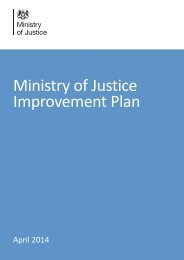knife-possession-sentencing-bulletin-q1-2015
knife-possession-sentencing-bulletin-q1-2015
knife-possession-sentencing-bulletin-q1-2015
Create successful ePaper yourself
Turn your PDF publications into a flip-book with our unique Google optimized e-Paper software.
Knife Possession Sentencing<br />
Quarterly, England and Wales<br />
January to March <strong>2015</strong><br />
Ministry of Justice<br />
Statistics <strong>bulletin</strong><br />
Published 11 June <strong>2015</strong>
Contents<br />
Contents 2<br />
Introduction 3<br />
Key findings 5<br />
Knife Possession Sentencing 6<br />
Annex A: List of Accompanying Tables 10<br />
Annex B: Key Events 12<br />
Annex C: Assessing the accuracy of estimation method 13<br />
Annex D: Explanatory notes 15<br />
Annex E: Other <strong>knife</strong> and sharp object related statistical released 17<br />
Annex F: Glossary 18<br />
Contacts 19<br />
2
Introduction<br />
This <strong>bulletin</strong> presents key statistics describing the trends in the number of offenders<br />
receiving cautions and convictions, being under probation supervision and in the<br />
prison population for <strong>possession</strong> of <strong>knife</strong> offences in England and Wales. This<br />
<strong>bulletin</strong> does not cover all <strong>knife</strong> crimes (offences involving a <strong>knife</strong>) as published by<br />
the Office for National Statistics 1 .<br />
The publication provides provisional figures for the latest quarter (January to March<br />
<strong>2015</strong>) with accompanying commentary and analysis. The information provided is a<br />
summary of three types of <strong>knife</strong> and weapon <strong>possession</strong> offences:<br />
<br />
<br />
<br />
<strong>possession</strong> offences of having an article with a blade or point in a public place or<br />
on school premises,<br />
<strong>possession</strong> of offensive weapon without lawful authority or reasonable excuse in<br />
a public place or on school premises,<br />
offences involving threatening with a <strong>knife</strong> or offensive weapson in a public place<br />
or on school premises (introduced on 3 rd December 2012 2 – an aggravated form<br />
of a <strong>possession</strong> offence occurs when an offender in <strong>possession</strong> of a <strong>knife</strong> or<br />
offensive weapon uses it to threaten and endangers others).<br />
In previous <strong>bulletin</strong>s where reference was made to <strong>knife</strong> <strong>possession</strong> offences only<br />
offences involving the <strong>possession</strong> of knives or offensive weapons were included, key<br />
statistics describing the trends in aggravated offences were presented separately. In<br />
this <strong>bulletin</strong> where reference is made to <strong>knife</strong> <strong>possession</strong> offences all three types, as<br />
described above, are included. This change has been made so that overall trends in<br />
the <strong>possession</strong> of <strong>knife</strong> offences in England and Wales can be presented. Tables<br />
providing information for each of the three offence groups individually are also<br />
presented.<br />
The key events that might be expected to affect the statistics presented in this<br />
<strong>bulletin</strong> can be found in Annex B.<br />
Data Sources<br />
This report draws on data from the following sources:<br />
<br />
Data on cautions and convictions are collected from the Police National<br />
Computer (PNC) – tables 1-9. Due to the number of updates as more case<br />
information becomes available on the PNC an estimation methodology is used to<br />
estimate the number and breakdown of disposals given for the <strong>possession</strong> of a<br />
1 www.ons.gov.uk/ons/rel/crime-stats/crime-statistics/year-ending-december-2014/crime-in-england-and-wales--<br />
year-ending-december-2014.html#tab-Offences-involving-knives-and-sharp-instruments. Details of other official<br />
statistics publications regarding <strong>knife</strong> related statistics can be found in Annex E.<br />
2 www.gov.uk/government/news/new-sentences-and-criminal-offences-come-into-effect.<br />
3
The probation data has been drawn from local probation administrative IT<br />
systems – tables 10 - 12<br />
Prison population are drawn from prison administrative IT systems.<br />
Feedback requested<br />
The structure and content of this report is continually being reviewed to reflect user<br />
requirements. If you have any feedback about these changes, or report more<br />
generally, please contact the production team using the contact details at the back of<br />
the report.<br />
Current and previous editions of this publication are available for download at<br />
www.gov.uk/government/organisations/ministry-of-justice/series/<strong>knife</strong>-<strong>possession</strong><strong>sentencing</strong>-quarterly.<br />
The next publication of the Knife Possession Sentencing Quarterly is scheduled to be<br />
published on 10th September <strong>2015</strong>, covering the period April to June <strong>2015</strong>.<br />
4
Key findings<br />
Estimates indicate that for the period January to March <strong>2015</strong> (Q1 <strong>2015</strong>):<br />
the total number of offences formally dealt with by the criminal justice system<br />
(CJS) for the <strong>possession</strong> of <strong>knife</strong> offences continues to be relatively stable. In the<br />
latest quarter; 4,117 offences were dealt with by the CJS, compared to 3,992<br />
offences in Q1 2014 and 4,083 in the previous quarter.<br />
Of those crimes;<br />
the number of adult offenders given cautions continues to fall - in the latest<br />
quarter just 10% of adult offenders received a caution, this is the lowest level it<br />
has been since 2007.<br />
the use of suspended sentences continues to increase and is now at its highest<br />
level since their introduction in April 2005. More than one in five (23%) of adult<br />
offenders now receive a suspended sentence for these offences, an increase of<br />
22% when compared with Q1 2014 and 4% higher when compared with the<br />
previous quarter.<br />
compared to 7 years ago, juvenile offenders are now more likely to receive an<br />
immediate custodial sentence; 13% of juvenile offenders received an immediate<br />
custodial sentence compared to 6% in Q1 2008.<br />
aggravated <strong>possession</strong> of a <strong>knife</strong> or offensive weapon accounted for 3% of all<br />
<strong>knife</strong> <strong>possession</strong> offences.<br />
5
Knife Possession Sentencing<br />
The total number of offences formally dealt with by the criminal justice system (CJS)<br />
for the <strong>possession</strong> of <strong>knife</strong> offences continues to be relatively stable. In the latest<br />
quarter, 4,117 offences were dealt with by the CJS, compared to 3,992 offences in<br />
Q1 2014 and 4,083 in the previous quarter.<br />
On 3 rd December 2012 an aggravated form of a <strong>possession</strong> offence was introduced.<br />
This offence occurs when an offender in <strong>possession</strong> of a <strong>knife</strong> or offensive weapon<br />
uses it to threaten and endangers others i.e. offences relate to threatening offences<br />
rather than offences where a <strong>knife</strong> is actually used. In Q1 <strong>2015</strong> this offence<br />
accounted for 3% of all <strong>knife</strong> <strong>possession</strong> offences.<br />
The levels of police recorded crime 3 for offences involving a <strong>knife</strong> or sharp instrument<br />
over the same period has also been relatively stable. In the year ending December<br />
2014 the police recorded 26,000 offences involving a <strong>knife</strong> or sharp instrument, 1%<br />
less than the same period a year ago.<br />
Figure 1: Proportion of type of disposal given for <strong>knife</strong> <strong>possession</strong> offences in<br />
England and Wales, between Q1 2013 and Q1 <strong>2015</strong><br />
35%<br />
Caution Absolute / Conditional discharge Fine<br />
Community sentence Suspended sentence Immediate custody<br />
Other disposal<br />
30%<br />
Proportion of all disposals<br />
25%<br />
20%<br />
15%<br />
10%<br />
5%<br />
0%<br />
Q1 2008<br />
Q2 2008<br />
Q3 2008<br />
Q4 2008<br />
Q1 2009<br />
Q2 2009<br />
Q3 2009<br />
Q4 2009<br />
Q1 2010<br />
Q2 2010<br />
Q3 2010<br />
Q4 2010<br />
Q1 2011<br />
Q2 2011<br />
Q3 2011<br />
Q4 2011<br />
Q1 2012<br />
Q2 2012<br />
Q3 2012<br />
Q4 2012<br />
Q1 2013<br />
Q2 2013<br />
Q3 2013<br />
Q4 2013<br />
Q1 2014<br />
Q2 2014<br />
Q3 2014<br />
Q4 2014<br />
Q1 <strong>2015</strong><br />
Notes:<br />
1) Figures for Q2 – Q4 2014 and Q1 <strong>2015</strong> include estimated figures based on historial data changes. Please see Annex C for further details.<br />
2) From Q1 2013 offences involving threatening with a <strong>knife</strong> or offensive weapon have been included.<br />
The most common disposal for a <strong>knife</strong> <strong>possession</strong> offence continues to be immediate<br />
custodial sentences (30%) followed by community sentences (26%).<br />
Adult offenders were more likely to receive an immediate custodial sentence for <strong>knife</strong><br />
<strong>possession</strong> offences (34%). However, the use of suspended sentences continues to<br />
increase and in the latest quarter more than one in five (23%) of adult offenders<br />
3<br />
www.ons.gov.uk/ons/rel/crime-stats/crime-statistics/year-ending-december-2014/crime-in-england-and-wales--year-endingdecember-2014.html#tab-Offences-involving-knives-and-sharp-instruments<br />
6
eceived a suspended sentence; an increase of 22% when compared with Q1 2014<br />
and 4% higher over the previous quarter.<br />
Over time there has been a significant fall in the proportion of adult offenders given a<br />
caution. In the latest quarter, 10% of adults offenders received a caution which is the<br />
lowest level it has been since 2007. This decline has in part been driven by the<br />
revised guidance on cautions that was issued in November 2013. The guidance<br />
made it clear that simple cautions should not be given for <strong>possession</strong> of a <strong>knife</strong>, and<br />
other serious either way offences, unless their issue was signed off by at least an<br />
Inspector. Since then statutory restrictions around the use of cautions, including their<br />
use for <strong>possession</strong> of a <strong>knife</strong>, have also been included in the Criminal Justice and<br />
Courts Act <strong>2015</strong> 4 which came into force in April <strong>2015</strong>.<br />
Juvenile offenders were more likely to receive a community sentence for <strong>possession</strong><br />
of a <strong>knife</strong> offence (52%). Just over a quarter (28%) were given a youth caution 5 - this<br />
proportion has remained relatively stable during the last 12 months, but is<br />
significantly lower than in Q1 2008 where 47% of juvenile offenders received<br />
cautions.<br />
There has also been an increase in the number of juvenile offenders receiving an<br />
immediate custodial sentence; in Q1 <strong>2015</strong> 13% of juvenile offenders received an<br />
immediate custodial sentence compared with 6% in Q1 2008.<br />
Criminal history of those cautioned or sentenced for <strong>knife</strong> <strong>possession</strong> offences<br />
Offenders with no previous <strong>knife</strong> <strong>possession</strong> offences were more likely to receive a<br />
community sentence (30%) in the 12 months ending March <strong>2015</strong>, whereas offenders<br />
with at least one previous <strong>possession</strong> offence on their record were more likely to<br />
receive an immediate custodial sentence (45%).<br />
The likelihood of a custodial sentence for adult offenders rose in relation to the<br />
number of previous <strong>possession</strong> offences; 24% of adult offenders with no previous<br />
convictions received an immediate custodial sentence compared to 57% for those<br />
with three or more previous offences.<br />
Juvenile offenders were more likely to receive a community sentence whether or not<br />
they had a previous <strong>knife</strong> <strong>possession</strong> offence; 54% of those with no previous <strong>knife</strong><br />
<strong>possession</strong> offences and 63% of those with one or more previous <strong>knife</strong> <strong>possession</strong><br />
offence. Only 3% of juvenile offenders received a caution after having a previous<br />
<strong>possession</strong> offence which compares to 33% of offenders with no previous<br />
<strong>possession</strong> offences.<br />
4<br />
See section 17 at www.gov.uk/government/uploads/system/uploads/attachment_data/file/428204/cjc-act-circular.pdf<br />
5<br />
Since April 8 th 2013 youth cautions were introduced replacing reprimands and warnings for young offenders.<br />
7
Offenders commencing probation<br />
In Q1 <strong>2015</strong> there were 1,061 court order starts under probation supervision for<br />
<strong>possession</strong> of an offensive weapon; this represents an increase of 3% from Q1 2014<br />
and 19% from Q1 2013. Community orders decreased by 8% over the past year,<br />
whilst suspended sentence orders increased by 19%.<br />
The proportion of those given unpaid work for community orders, as a percentage of<br />
all requirements, has risen over the past year, from 29% to 32%; for suspended<br />
sentence orders it fell from 26% to 23%.<br />
Where unpaid work requirements were started under community orders the<br />
proportion of longer requirements has decreased over the past year; for suspended<br />
sentence orders the proportion has also decreased.<br />
<br />
<br />
For community orders, in Q1 <strong>2015</strong>, 11% of unpaid work requirements were<br />
recorded as being 200 hours or longer, compared to 12% in Q1 2014.<br />
For suspended sentence orders, in Q1 <strong>2015</strong>, 15% of unpaid work<br />
requirements were recorded as being 200 hours or longer, compared to 17%<br />
in Q1 2014.<br />
Offenders in prison for <strong>knife</strong> <strong>possession</strong> offences<br />
480 offenders were in prison serving a sentence for <strong>possession</strong> of an offensive<br />
weapon on 27 March <strong>2015</strong>, up 24% from a year ago and reversing the overall<br />
downward trend seen in the prison population for this offence since early 2009. This<br />
trend now appears to coincide with the general increasing use and length of custodial<br />
sentences for <strong>possession</strong> offences.<br />
8
Figure 2: Prison population under sentence for <strong>possession</strong> of an offensive<br />
weapon 6 (excludes recalls) in England and Wales, between January 2008 and<br />
March <strong>2015</strong><br />
Number of prisoners under immediate custodial sentence<br />
900<br />
800<br />
700<br />
600<br />
500<br />
400<br />
300<br />
200<br />
100<br />
2008 2009 2010 2011<br />
2012<br />
2013<br />
2014<br />
0<br />
Jan-08<br />
Mar-08<br />
May-08<br />
Jul-08<br />
Sep-08<br />
Nov-08<br />
Jan-09<br />
Mar-09<br />
May-09<br />
Jul-09<br />
Sep-09<br />
Nov-09<br />
Jan-10<br />
Mar-10<br />
May-10<br />
Jul-10<br />
Sep-10<br />
Nov-10<br />
Jan-11<br />
Mar-11<br />
May-11<br />
Jul-11<br />
Sep-11<br />
Nov-11<br />
Jan-12<br />
Mar-12<br />
May-12<br />
Jul-12<br />
Sep-12<br />
Nov-12<br />
Jan-13<br />
Mar-13<br />
May-13<br />
Jul-13<br />
Sep-13<br />
Nov-13<br />
Jan-14<br />
Mar-14<br />
May-14<br />
Jul-14<br />
Sep-14<br />
Nov-14<br />
Jan-15<br />
Mar-15<br />
Due to technical problems relating to the supply of statistical information, it is not possible to provide figures from July 2009 to March 2010<br />
6<br />
Includes having an article with a blade or a point.<br />
9
Annex A: List of Accompanying Tables<br />
Accompanying this publication are the following tables<br />
Table 1<br />
Table 1a<br />
Table 1b<br />
Table 2<br />
Table 3<br />
Table 4<br />
Table 5<br />
Table 6<br />
Table 7<br />
Table 8<br />
Knife Possession offences resulting in a caution or sentence, in<br />
England and Wales, annually from year ending March 2009 and<br />
quarterly from Q4 2007<br />
Offences involving the <strong>possession</strong> of a <strong>knife</strong> or offensive weapon<br />
resulting in a caution or sentence, in England and Wales, annually from<br />
year ending March 2009 and quarterly from Q4 2007<br />
Offences involving threatening with a <strong>knife</strong> or offensive weapon<br />
resulting in a caution or sentence, in England and Wales, annually from<br />
year ending March 2014 and quarterly from Q1 2013<br />
Offences involving the <strong>possession</strong> of a <strong>knife</strong> or offensive weapon<br />
resulting in a caution or sentence by age group, in England and Wales,<br />
annually from year ending March 2009 and quarterly from Q4 2007<br />
Offences involving the <strong>possession</strong> of a <strong>knife</strong> or offensive weapon<br />
resulting in a caution or sentence by type of offence, in England and<br />
Wales, annually from year ending March 2009 and quarterly from Q4<br />
2007<br />
Offences involving the <strong>possession</strong> of a <strong>knife</strong> or offensive weapon<br />
resulting in an immediate custodial sentence, in England and Wales,<br />
annually from year ending March 2009 and quarterly from Q4 2007<br />
Offences involving the <strong>possession</strong> of a <strong>knife</strong> or offensive weapon<br />
resulting in a caution or sentence by police force area, in England and<br />
Wales, annually from year ending March 2009<br />
Number of previous convictions or cautions for the <strong>possession</strong> of a<br />
<strong>knife</strong> or offensive weapon offences for offenders convicted or cautioned<br />
for a <strong>possession</strong> offence by disposal category, in England and Wales,<br />
annually from year ending March 2009<br />
Number of previous convictions or cautions for the <strong>possession</strong> of a<br />
<strong>knife</strong> or offensive weapon offences for offenders convicted or cautioned<br />
for a <strong>possession</strong> offence by disposal category, broken down by age<br />
group, in England and Wales, annually from year ending March 2009<br />
Number of previous convictions or cautions for the <strong>possession</strong> of a<br />
<strong>knife</strong> or offensive weapon offences for offenders convicted or cautioned<br />
for threatening with a <strong>knife</strong> or offensive weapon by disposal category,<br />
broken down by age group, in England and Wales, annually from year<br />
ending March 2014<br />
10
Table 9<br />
Table 10<br />
Table 11<br />
Table 12<br />
Offences involving threatening with a <strong>knife</strong> or offensive weapon<br />
resulting in a caution or sentence by age group, in England and Wales,<br />
annually from year ending March 2014 and quarterly from Q1 2003<br />
Offenders commencing a court order under probation supervision for<br />
<strong>possession</strong> of an offensive weapon, in England and Wales, annually<br />
from year ending March 2009 and quarterly from Q4 2007<br />
Requirement starts for <strong>possession</strong> of offensive weapon, in England and<br />
Wales, annually from year ending March 2009 and quarterly from Q4<br />
2007<br />
Unpaid work requirements started by length of requirement given for<br />
<strong>possession</strong> of offensive weapon in England and Wales, annually from<br />
year ending March 2009 and quarterly from Q4 2007<br />
11
Annex B: Key Events<br />
The key events that might be expected to affect the statistics in this <strong>bulletin</strong> were:<br />
<br />
<br />
<br />
<br />
On 21 May 2008, the Court of Appeal issued the judgment in Povey 7 that said,<br />
because of prevalence, magistrates should normally sentence those convicted of<br />
<strong>knife</strong> crime <strong>possession</strong> offences at the top end of the range.<br />
The Sentencing Guidelines Council issued an update to the magistrates’ courts<br />
guidelines, with effect from 4 August 2008, which set out the effect of the Court of<br />
Appeal judgment and made it clear that the starting point for the lowest level of<br />
<strong>knife</strong> <strong>possession</strong> amongst adults should be 12 weeks’ custody. This applies in<br />
cases where a first time offender pleads not guilty to <strong>possession</strong> of a <strong>knife</strong> in nondangerous<br />
circumstances. A guilty plea would attract a discount in the normal<br />
way, as would any personal mitigation, and could take the sentence below the<br />
custody threshold.<br />
Since September 2008 all probation areas have been able to provide intensive<br />
delivery of 300 hour Community Payback sentences for unemployed offenders<br />
convicted of <strong>knife</strong> crime offences, who are on the brink of custody. In January<br />
2009 this offer of intensive delivery of a minimum of 18 hours per week over three<br />
days was extended to Community Payback sentences of any length imposed for<br />
an offence of <strong>knife</strong> crime, when an offender is unemployed.<br />
From 3 December 2012, a new offence of aggravated <strong>knife</strong> <strong>possession</strong> came into<br />
force. Anyone aged 16 or over who uses a <strong>knife</strong> or offensive weapon to threaten<br />
and endanger others will face a mandatory custodial sentence, unless the court<br />
considers there to be particular circumstances which would make it unjust to do<br />
so. 8<br />
7 Povey & Ors, R. v, Court of Appeal - Criminal Division, May 21, 2008, [2008] EWCA Crim 1261.<br />
8<br />
For legislation, see: www.legislation.gov.uk/ukpga/2012/10/contents/enacted<br />
12
Annex C: Assessing the accuracy of estimation method<br />
During the development of the October to December (Q4) 2013 bullein, a<br />
methodology was introduced to estimate the number and breakdown of disposals<br />
given for two types of <strong>knife</strong> <strong>possession</strong> offences:<br />
<br />
<br />
<strong>possession</strong> offences of having an article with a blade or point in a public place or<br />
on school premises,<br />
<strong>possession</strong> of offensive weapon without lawful authority or reasonable excuse in<br />
a public place or on school premises.<br />
This annex assesses the accuracy of this methodology.<br />
Whilst developing the builletin significant changes were seen in the disposal figures<br />
from those initially published for each quarter when compared with those released<br />
over the following year. The main reason for this change was that the data held on<br />
the Police National Computer (PNC) is updated with new information each month for<br />
not only the current month, but also for all previous months included in the PNC<br />
dataset. This difference was particularly noticeable for the number of immediate<br />
custodial sentences and other disposals. Initial investigations showed that the scale<br />
of the changes over time was stable, and so a new methodology was introduced to<br />
predict these final <strong>sentencing</strong> figures for the most recent four quarters.<br />
Table 1 below illustrates the accuracy of the estimation process that was used to<br />
provide the statistics that were published for Q1 2014 by comparing non-estimated<br />
and estimated figures by disposal group with the actual figures published one (Q1<br />
<strong>2015</strong>) year on.<br />
Table 1: Changes in the number of disposals reported for <strong>knife</strong> <strong>possession</strong><br />
offences in Q1 2014 between the non-estimated, estimated and final actual<br />
figures<br />
Disposal category<br />
Q1 2014 - non<br />
estimated<br />
Q1 2014-<br />
estimated<br />
Q1 2014 -<br />
actual figures<br />
% change - non<br />
estimated to<br />
actual figures<br />
% change -<br />
estimated to<br />
actual figures<br />
Caution 545 552 554 2 0<br />
Absolute/Conditional discharge 144 157 156 8 -1<br />
Fine 153 164 161 5 -2<br />
Community sentence 1,160 1138 1,149 -1 1<br />
Suspended sentence 624 606 616 -1 2<br />
Immediate custody 936 1099 1,118 19 2<br />
Other disposal 333 198 155 -53 -22<br />
All disposals 3,895 3,914 3,909 0 0<br />
13
As outlined above, figures show that there were large differences between the nonestimated<br />
and the actual final figures for those receiving an immediate custodial<br />
sentence or other disposal, with differences of 19% and 53% respectively. However,<br />
when the estimated figures are compared with the actual final figures for these two<br />
disposal categories there is less change, with difference of 2% and 22% respectively.<br />
The biggest impact/change is seen in an increase in the figures for immediate<br />
custody and related decrease in the ‘other disposal category’.<br />
This showed that the methodology being used had been successful in predicting the<br />
changes seen in disposals over the year and so it was decided that future <strong>bulletin</strong>s<br />
would continue to use this methodology for the most recent four quarters.<br />
We continue to review this methodology and provide updates on the accuracy of our<br />
estimates. In the future we are going to be looking into extending this estimation<br />
methodology for the aggravated <strong>knife</strong> offences.<br />
14
Annex D: Explanatory notes<br />
Data quality and sources<br />
Tables 1 to 9<br />
The statistics presented in tables 1 to 9 in this <strong>bulletin</strong> are drawn from an extract of<br />
data held on the Police National Computer (PNC) as at 1 st May <strong>2015</strong>.<br />
The PNC is a large administrative database containing information about police<br />
cautions and court convictions held by individual offenders in England and Wales. As<br />
an administrative system, the PNC is regularly updated as new information about<br />
particular individuals becomes available. For example, an offender with previous<br />
convictions may have recently been charged with another offence, appeared in court<br />
against this charge and then been subsequently convicted of this offence. This<br />
information would then be updated accordingly against that individual’s record in the<br />
PNC.<br />
As these updates involve some element of manual data entry alongside more<br />
automated systems, there can be delays in the database becoming updated with the<br />
latest information about an offender’s convictions. As such, the number of<br />
cautions/convictions recorded in the PNC extract for <strong>knife</strong> <strong>possession</strong> offences, in<br />
particular for the most recent quarter included in this <strong>bulletin</strong>, is likely to be lower than<br />
the actual number of cautions/convictions given in the period.<br />
In addition, the different disposals recorded in the PNC extract for <strong>knife</strong> <strong>possession</strong><br />
offences in recent quarters are also subject to some change. This is partly due to the<br />
delays in updating recent court outcomes on the PNC, but is also due to the fact that,<br />
while some individuals will have been convicted of a <strong>knife</strong> <strong>possession</strong> offence in a<br />
magistrate’s court during the quarter, information about the disposal they received is<br />
not yet available as the case has been passed to the Crown Court for <strong>sentencing</strong> at a<br />
later date. These cases will be updated when information about the final sentence<br />
given for the offence becomes available.<br />
As a result of these updates, the statistics presented in this <strong>bulletin</strong> for the most<br />
recent four quarters are based on estimates as described in Annex C.<br />
Tables 10 to 12 and Figure 3<br />
The probation data has been processed from data collected and held centrally by the<br />
Ministry of Justice. The data are drawn from the local probation administrative IT<br />
systems from each of the 35 probation trusts in England and Wales. The figures<br />
showing the numbers starting court orders relate to the number of offenders starting<br />
probation supervision in a given period. The numbers drawn from the PNC data in<br />
tables 1 to 5 relate to the total number of offences committed by offenders given<br />
particular disposals, which are likely to be greater than the number of offenders. Also,<br />
the probation data shows offenders convicted of the more general offence of<br />
‘<strong>possession</strong> of an offensive weapon’. This will include <strong>possession</strong> of knives, as well<br />
the particular offence of ‘<strong>possession</strong> of an article with a blade or point’, but these<br />
cannot be separately distinguished in the probation data.<br />
15
Prison population data presented in this <strong>bulletin</strong> are drawn from the prison<br />
administrative IT systems. The figures showing the numbers under sentence refer to<br />
the number of offenders serving a custodial sentence. Figures drawn from PNC data<br />
refer to the number of offences committed by offenders given particular disposals.<br />
Prison establishments routinely provide records of the numbers of persons held in<br />
custody at the end of each month, broadly subdivided according to age, sex, custody<br />
type and sentence length. The records are collated and processed centrally.<br />
However, data recorded by prisons only show the numbers serving a sentence for<br />
the general offence of “<strong>possession</strong> of an offensive weapon”. This offence includes<br />
the <strong>possession</strong> of a <strong>knife</strong> but can also include <strong>possession</strong> of other dangerous<br />
weapons (excluding firearms).<br />
Due to technical problems relating to the supply of data for statistical purposes it has<br />
not been possible to provide data relating to the prison population for specific offence<br />
types from July 2009 to March 2010.<br />
16
Annex E: Other <strong>knife</strong> and sharp object related statistical<br />
released<br />
Other government departments also release statistics relating to knives and sharp<br />
objects. Below are some links and brief outlines of other available sources.<br />
<br />
The Home Office provide a guidance document regarding the law for knives and<br />
offensive weapons.<br />
www.gov.uk/government/uploads/system/uploads/attachment_data/file/186911/K<br />
nives_and_offensive_weapons_information_GDS_FAQ.pdf<br />
www.gov.uk/find-out-if-i-can-buy-or-carry-a-<strong>knife</strong><br />
<br />
The Home Office also publish statistics of offences involving knives and sharp<br />
instruments. This is contained within the Crime in England and Wales statistical<br />
<strong>bulletin</strong> and has a section called Offences involving knives and sharp instruments.<br />
www.ons.gov.uk/ons/rel/crime-stats/crime-statistics/year-ending-december-<br />
2014/crime-in-england-and-wales--year-ending-december-2014.html#tab-<br />
Offences-involving-knives-and-sharp-instruments<br />
<br />
The Office for National Statistics publishes information on recorded crime for<br />
selected violent and sexual offences involving a <strong>knife</strong> or sharp instrument and<br />
offences involving firearms, see additional Tables 9 and 10.<br />
www.ons.gov.uk/ons/publications/re-reference-tables.html?edition=tcm%3A77-<br />
372973<br />
<br />
The Department for Health release hospital admission data for assaults on an ad<br />
hoc basis. Within this data there is a category for X99 - Assault by sharp object.<br />
The link for the most recently released publication is listed below and the data can<br />
usually be found in the Monthly HES data – Monthly topic of interest section of the<br />
HES online website.<br />
www.hscic.gov.uk/hes<br />
17
Annex F: Glossary<br />
Adult: An offender aged 18 and over.<br />
Caution: A warning given to adult offenders who admit guilt and agree to be<br />
cautioned. They are issued on the instructions of a senior police officer where there<br />
is sufficient evidence for a conviction and it is not considered to be in the public<br />
interest to institute criminal proceedings.<br />
Community sentence: An alternate to custodial sentence (sending offenders to<br />
prison) which allows offenders to make amends for their crimes. For juveniles the<br />
main community sentence used are the referral order and the Youth Rehabilitation<br />
Order (YRO). With a community sentence there are specific things the offender can,<br />
can’t and must do while serving their sentence. Elements of a community sentence<br />
include: Supervision, Unpaid work, Specified activities, Prohibited activities,<br />
Accredited programmes, Curfew, exclusion, Residence, Mental health treatment,<br />
Drug rehabilitation, Alcohol treatment and attendance centre requirement for under<br />
25s.<br />
England and Wales – Total figures for England and Wales now include all police<br />
forces in England and Wales and the British Transport Police (BTP). The Home<br />
Office is responsible for policing the 43 police forces in England and Wales. There<br />
are also other authorities who prosecute offenders such as: Department for Work and<br />
Pensions (DWP), HM Revenue and Customs (HMRC) and Ministry of Defence<br />
(MOD).<br />
Immediate custody: Unsuspended imprisonment for adults aged 21 or over and<br />
detention in a young offender institution for those aged 18 to 20. The maximum<br />
sentence available is 4 years. Juveniles aged 12 to 17 may receive a detention and<br />
training order of 4, 6, 8, 10,12, 18 or 24 months.<br />
Juvenile: An offender between the ages 10 and 17.<br />
Offensive weapon: Any article made or adapted for use for causing injury to the<br />
person, or intended by the person having it with him for such. Examples includes: a<br />
swordstick, a hollow walking-stick or cane containing a blade.<br />
Reprimand and warning: Issued to juvenile first time offenders for minor offences.<br />
Reprimand and warning for juveniles are equivalent of cautions for adults. These<br />
were replaced by youth cautions on April 8 th 2013.<br />
Youth cautions: Introduced on April 8 th 2013. They are formal out-of-court disposals<br />
for young offenders (aged 10 to 17) and intended to allow a more flexible response to<br />
offending than the preceding Final Warning Scheme. These now replace reprimands<br />
and warnings.<br />
Suspended Sentence: A custodial sentence of 6 months or less in magistrate’s<br />
courts and 2 years or less in the Crown Court, suspended for a period ranging from<br />
six months to two years available for adults only.<br />
18
Contacts<br />
Press enquiries on the contents of this <strong>bulletin</strong> should be directed to the Ministry of<br />
Justice press office:<br />
Tel: 020 3334 3555<br />
Email: newsdesk@justice.gsi.gov.uk<br />
Other enquiries about these statistics should be directed to the Justice Statistics<br />
Analytical Services division of the Ministry of Justice:<br />
Craig Medhurst<br />
Ministry of Justice<br />
Justice Statistical Analytical Services<br />
7 th Floor<br />
102 Petty France<br />
London<br />
SW1H 9AJ<br />
Email: statistics.enquiries@justice.gsi.gov.uk<br />
General enquiries about the statistical work of the Ministry of Justice can be e-mailed<br />
to: statistics.enquiries@justice.gsi.gov.uk<br />
General information about the official statistics system of the United Kingdom is<br />
available from www.statistics.gov.uk<br />
© Crown copyright <strong>2015</strong><br />
Produced by the Ministry of Justice<br />
You may re-use this information (not including logos) free of charge in any format or<br />
medium, under the terms of the Open Government Licence. To view this licence, visit<br />
www.nationalarchives.gov.uk/doc/open-government-licence/ or email:<br />
psi@nationalarchives.gsi.gov.uk<br />
Where we have identified any third party copyright material you will need to obtain<br />
permission from the copyright holders concerned.<br />
19


